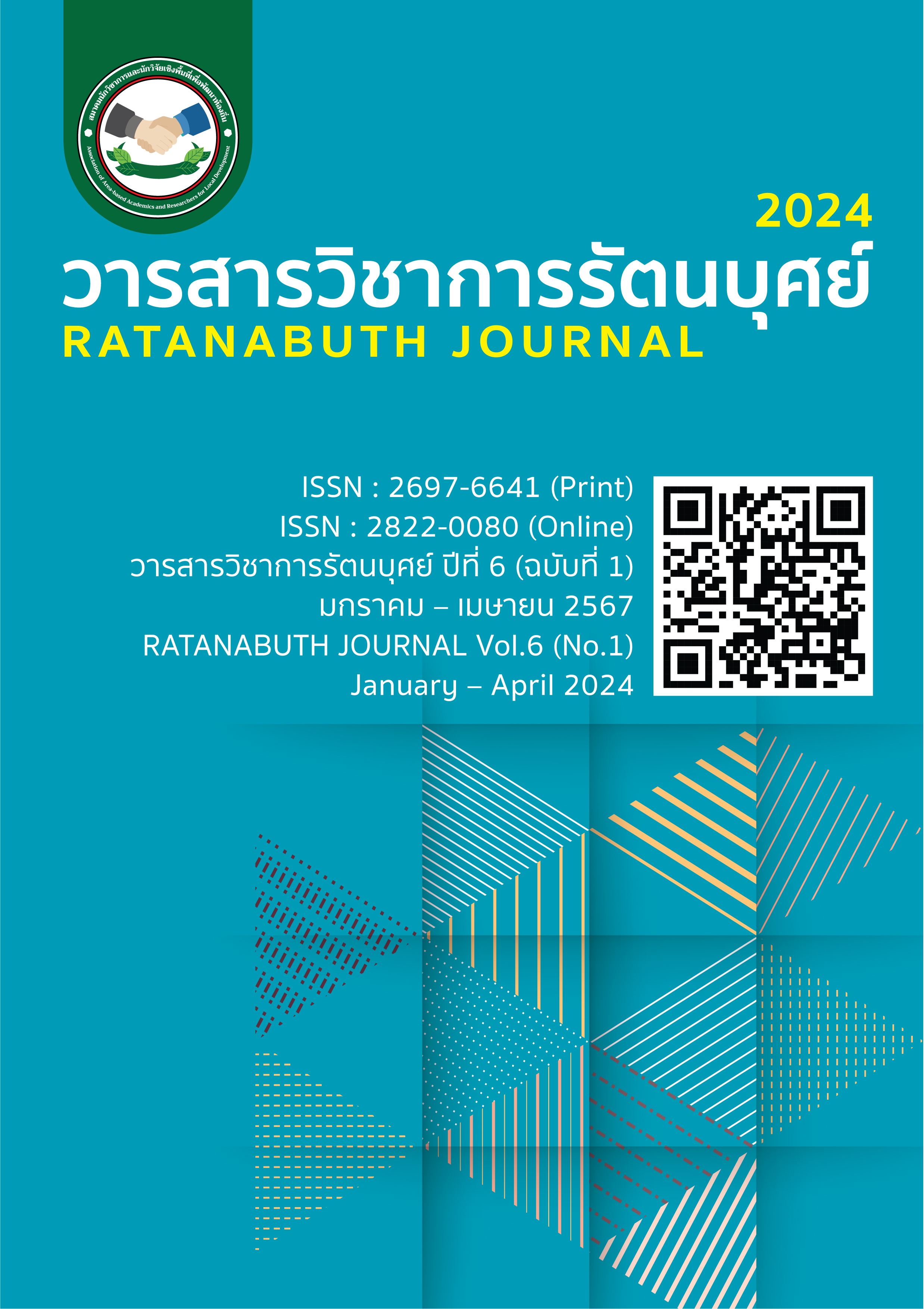The Development Model for Servant Leadership of Teacher Under The Primary Educational Service Area Office in Roi-Kean-Sara-Sin Province The Development Model for Servant Leadership of Teacher Under The Primary Educational Service Area Office in Roi-Kean-Sara-Sin Province
Main Article Content
Abstract
The purposes of this research were 1) to study the components and indicators of servant leadership of teacher. 2) to study the current situation, desirable condition and needs assessment of servant leadership of teacher under the primary educational service area office in Roi-Kean-Sara-Sin province. 3) create a model developing for servant leadership of teacher under the primary educational service area office in Roi-Kean-Sara-Sin province. 4) to study the results of using the model developing for servant leadership of teacher under the primary educational service area office in Roi-Kean-Sara-Sin province. The key informant group was 7 experts to confirm the components and indicators, 9 experts to draft model, 9 experts to confirm model and target groups were 15 teachers for study the results of using the model developing. The sample group consisted of 379 school administrators and teachers. The research tool was a interview form and questionnaire. Data were analyzed by means and standard deviation
The research results found that: 1. The components and indicators of servant leadership of teacher, consisted of 5 components, Include 1) Building community 2) Value people 3) Commitment to the growth of people 4) Develop people 5) Building trust. 2. The overall current condition is at a high average level. The overall desirable condition was at the highest mean level. The Needs assessment was ranked from highest to lowest as follows: 1) Building trust 2) Value people 3) Commitment to the growth of people 4) Building community 5) Develop people.3. The model consists of components : 1) principles, 2) objectives, 3) content, 4) development process, and 5) measurement and evaluation. The model has a suitability assessment result. possibility and the overall usefulness of the model was at the highest level. 4. Results of the study using the model overall, the indicators were followed at the highest level. The results of the satisfaction assessment, the overall use of the model, satisfaction was at the highest level.
Article Details

This work is licensed under a Creative Commons Attribution-NonCommercial-NoDerivatives 4.0 International License.
References
ธีระ รุญเจริญ. (2550). รูปแบบและองค์ประกอบของรูปแบบ. อุบลราชธานี : มหาวิทยาลัยอุบลราชธานี.
รังสรรค์ ประเสริฐศรี. (2544). Leadership ภาวะผู้นำ. กรุงเทพฯ: ธนธัชการพิมพ์.
วันทนา เนาว์วัน. (2557). การพัฒนาภาวะผู้นาตามหลักพุทธธรรมของบุคลากรโรงเรียนพระปริยัติธรรมแผนกสามัญศึกษา กลุ่ม 3. (วิทยานิพนธ์ปริญญาพุทธศาสตรดุษฎีบัณฑิต) มหาวิทยาลัยมหาจุฬาลงกรณราชวิทยาลัย.
สถาบันวิจัยเพื่อการพัฒนาประเทศไทย. (2556). การทำยุทธศาสตร์การปฏิรูปการศึกษาขั้นพื้นฐานให้เกิดความรับผิดชอบ. กรุงเทพฯ : ม.ป.พ..
สถาบันวิจัยเพื่อความเสมอภาคทางการศึกษา. (2564). ภาวะผู้นำสมัยใหม่ โลกใบใหม่ที่ครูต้องเรียนรู้.สืบค้นเมื่อ 20 สิงหาคม 2566 จาก https://research.eef.or.th/teacher-leadership/
สมาน อัศวภูมิ. (2550). การใช้วิจัยพัฒนารูปแบบในวิทยานิพนธ์ระดับปริญญาเอก. เอกสารประกอบการสอนวิชาสัมมนาการศึกษาระดับปริญญาเอก. หน้า 50-53. อุบลราชธานี: มหาวิทยาลัยราชภัฏอุบลราชธานี.
สัมฤทธิ์ กางเพ็ง และ สรายุทธ กันหลง. (2553). ภาวะผู้นำใฝ่บริการในองค์การ : แนวคิด หลักการ ทฤษฎีและงานวิจัย. (พิมพ์ครั้งที่ 2). ขอนแก่น: คลังนานาวิทยา.
สุวิมล ว่องวาณิช. (2558). การวิจัยประเมินความต้องการจำเป็น. กรุงเทพฯ : สำนักพิมพ์แห่งจุฬาลงกรณ์มหาวิทยาลัย.
สิริกร ไชยราช. (2562). การพัฒนารูปแบบการพัฒนาภาวะผู้นำครูในการจัดการเรียนรู้ตามหลักปรัชญาของเศรษฐกิจพอเพียงในโรงเรียนมัธยมศึกษา สังกัดสำนักงานศึกษาธิการภาค 11. วิทยานิพนธ์ครุศาสตรดุษฎีบัณฑิต. มหาวิทยาลัยราชภัฏสกลนคร.
สำนักงานเขตพื้นที่การศึกษาประถมศึกษามหาสารคาม เขต 1. (2565). รายงานผลดําเนินงานประจำปีงบประมาณ พ.ศ. 2565. มหาสารคาม : กลุ่มนโยบายและแผน สพป.มหาสารคาม เขต 1.
Anderson, K. P. (2005). A correlational analysis of servant leadership and job satisfaction in a religious education organization. (Doctoral dissertation) University of Phoenix, USA.
Cerit, Yusuf. (2010). The Effects of Servant Leader ship Behaviours of School Principals on Teachers’ Job Satisfaction. INT. J. LEADERSHIP IN EDUCATION,13(3), 301–317.
Daft, R.L. (2002). The Leadership Experience. (2nd ed). Fort Worth, Tx: Harcourt, College.
Eisner, E. (1976). Educational Connoisseurship and Criticism : Their form and Functions in Educational Evaluation. Journal of Aesthetic Evaluation or Education. 10, 1976.
Greenleaf, R.K. (2002). Servant Leadership: A Journey into the Nature of Legitimate Power and Greatness. NJ: Paulist Press.
Hays, JM. (2008). Teacher as servant applications of Greenleaf's servant leadership in higher education. Journal of Global Business Issues.
Joyce, B.R., and Weil, M. (2000). Models of Teaching. (6th ed). Massachusetts: Allyn & Bacon.
Krejcie, R. V. & Morgan, D. W. (1970). Determining Sample Size for Research Activities. Educational and Psychological Measurement.
Laub, J. (2004). Organizational Leadership Assessment (OLA) Model. Defining servant leadership and the healthy organization.
Patterson, K. (2003). Servant leadership : A theoretical model. (Doctoral dissertation). Regent University, Virginia Beach, VA. USA.
Spears, L. C. (2004). The Understanding and practice of Servant - leadership. In L.C. Spears, & M. Lawrence (Eds), Practicing servant leadership : Succeeding.
Valdemar A. H. (2008). Employee satisfaction and organizational commitment: A mixed methods investigation of effects of servant leadership. (Doctoral dissertation). Capella University, USA.


